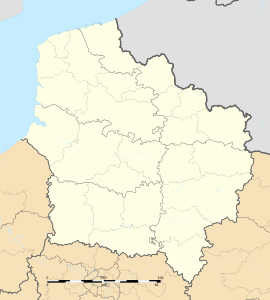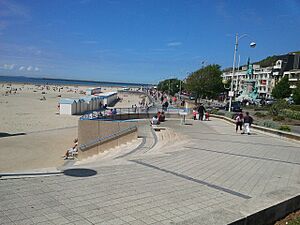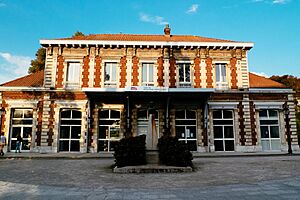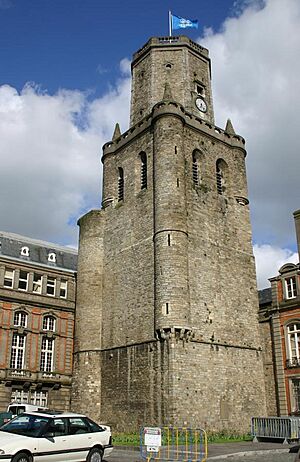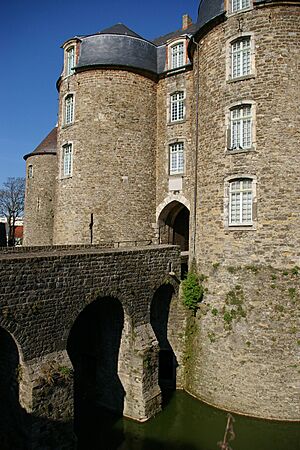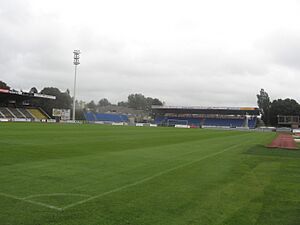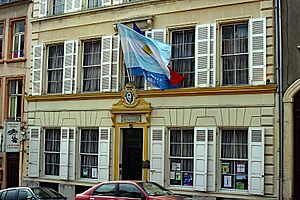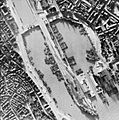Boulogne-sur-Mer facts for kids
Quick facts for kids
Boulogne-sur-Mer
|
|||
|---|---|---|---|
|
Subprefecture and commune
|
|||
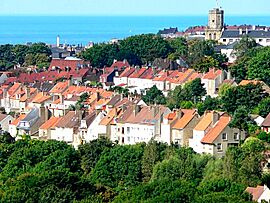
A general view from the Brecquerecque Quarter:
The modern lighthouse, the medieval bell tower and the English Channel |
|||
|
|||
| Country | France | ||
| Region | Hauts-de-France | ||
| Department | Pas-de-Calais | ||
| Arrondissement | Boulogne-sur-Mer | ||
| Canton | Boulogne-sur-Mer-1 and 2 | ||
| Intercommunality | CA du Boulonnais | ||
| Area
1
|
8.42 km2 (3.25 sq mi) | ||
| • Urban | 62.8 km2 (24.2 sq mi) | ||
| • Metro | 667 km2 (258 sq mi) | ||
| Population
(2021)
|
40,910 | ||
| • Density | 4,859/km2 (12,584/sq mi) | ||
| • Urban
(2018)
|
84,676 | ||
| • Urban density | 1,348.3/km2 (3,492.2/sq mi) | ||
| • Metro
(2018)
|
160,130 | ||
| • Metro density | 240.07/km2 (621.8/sq mi) | ||
| Demonym(s) | Boulonnaise | ||
| Time zone | UTC+01:00 (CET) | ||
| • Summer (DST) | UTC+02:00 (CEST) | ||
| INSEE/Postal code |
62160 /62200
|
||
| Elevation | 0–110 m (0–361 ft) | ||
| Website | http://www.ville-boulogne-sur-mer.fr/ | ||
| 1 French Land Register data, which excludes lakes, ponds, glaciers > 1 km2 (0.386 sq mi or 247 acres) and river estuaries. | |||
Boulogne-sur-Mer is a lively coastal city in Northern France. People often just call it Boulogne. It's located in the Pas-de-Calais area, right on the English Channel.
This city is part of the beautiful Côte d'Opale, a popular French coastline. It's the second-largest city in its department, after Calais. Boulogne is also famous for being France's biggest fishing port, especially known for herring.
Boulogne is a very old city with a rich history. The Romans used it as a main port to connect with Britain. Later, during the Middle Ages, it became part of the Kingdom of France.
The city was often fought over by France and England. In 1805, Napoleon gathered his troops here, planning to invade the United Kingdom.
Today, Boulogne has a 12th-century belfry (bell tower) that is a UNESCO World Heritage Site. Another popular spot is Nausicaa, a cool marine conservation center.
Contents
What's in a Name?
The name Boulogne comes from the Latin word Bononia. This word might mean "foundation," "citadel," or "granary" in an old Celtic language.
The "sur-Mer" part means "on sea" in French. This helps tell it apart from Boulogne-Billancourt, a town near Paris. That town's name actually comes from a church dedicated to "Our Lady of Boulogne[-sur-Mer]".
A Look Back in Time
How Boulogne Began
The city, once called Gesoriacum by the Romans, was first settled by the Celtic Boii tribe. Around 39 AD, the Roman Emperor Caligula ordered a tall lighthouse, the Tour d'Ordre, to be built here. This was possibly to prepare for an invasion of Britain. Sadly, the lighthouse fell into the sea in 1644 due to coastal erosion.
From 43 AD, Gesoriacum was the main port connecting the Roman Empire to Britain. It was a key base for the Roman navy. Later, the city's name changed to Bononia.
The Middle Ages
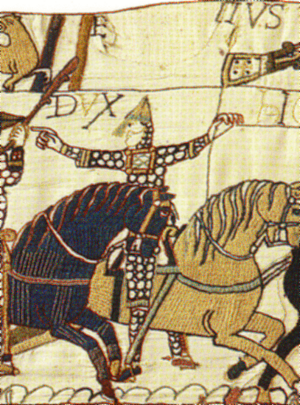
In the Middle Ages, Boulogne was the capital of its own county. A famous Count, Eustace II of Boulogne, helped William the Conqueror take over England. His wife started the city's Notre Dame cathedral. This cathedral became a popular place for pilgrimages, visited by many kings.
The city was important for herring fishing. It also got its official city rights in 1203. France and England often fought over the area. The English occupied Boulogne several times during the Hundred Years War. In 1550, France bought Boulogne back from England.
The 19th Century
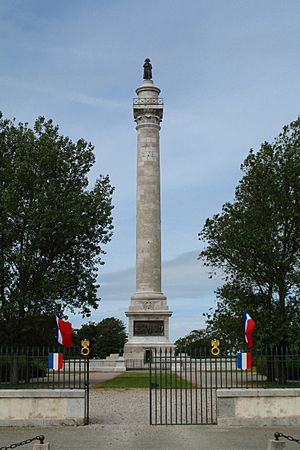
In 1800, Boulogne became a "subprefecture" in France. It was even called an "Imperial City" in 1803. The 1800s were a good time for Boulogne. It became a popular beach resort for wealthy Parisians. This happened after a railway connected the city to Paris in 1848.
During the Napoleonic Wars, Napoleon gathered a huge army in Boulogne. He planned to invade the United Kingdom in 1805. However, his plans changed due to other events in Europe and the strong British navy.
World Wars

During World War I, Boulogne was a very important port for the British army. Many soldiers and supplies came through here. It was also a major hospital area.
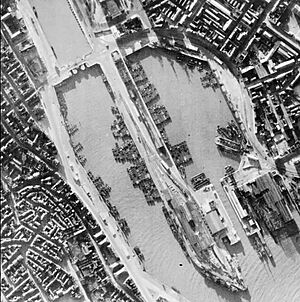
In World War II, Boulogne faced heavy fighting. In May 1940, British soldiers tried to defend the city against a German attack. Many were evacuated by the Royal Navy. In June 1944, the British Royal Air Force bombed Boulogne harbour to stop German naval activity. The harbour was badly damaged.
In September 1944, the city was liberated by Canadian forces. After the war, new buildings were constructed to replace what was destroyed.
Where is Boulogne?
Location and Surroundings
Boulogne-sur-Mer is in Northern France, right on the English Channel. It's at the mouth of the Liane river. It's about 30 kilometers (19 miles) from Calais and 50 kilometers (31 miles) from Folkestone in England.
Boulogne is an important city in the North of France. It influences the surrounding 74 towns and villages. The coast has beautiful tourist spots like Cap Gris Nez and Cap Blanc Nez. These are the closest points in France to England. There are also nice seaside resorts nearby.
City Areas
The city is divided into several main areas:
- City Centre: This area has historic buildings, shops, banks, and pedestrian streets.
- Fortified Town: This is the old part of the city. It has many historic monuments like the castle-museum, basilica, and belfry. It's surrounded by 13th-century walls, which are great for walks.
- Gambetta-Sainte-Beuve: A tourist area near the beach and the recreational harbor.
- Capécure: An industrial area around the harbor.
- Saint-Pierre: This was once a fishing neighborhood. It was rebuilt after World War II.
- Chemin Vert: An area built in the 1950s.
- Dernier Sou: A residential area in the east.
- Beaurepaire: A residential area in the north.
- Bréquerecque: A residential area in the south.
Climate
Boulogne-sur-Mer has an oceanic climate. This means it has cool winters and mild summers. The sea helps keep the temperatures from getting too extreme. It can get quite warm in summer, with average warmest days around 31°C (88°F). The city also gets more rain than some other coastal areas.
| Climate data for Boulogne-sur-Mer (1991–2020 normals), humidity 1973–1990, extremes since 1973 | |||||||||||||
|---|---|---|---|---|---|---|---|---|---|---|---|---|---|
| Month | Jan | Feb | Mar | Apr | May | Jun | Jul | Aug | Sep | Oct | Nov | Dec | Year |
| Record high °C (°F) | 16.4 (61.5) |
18.9 (66.0) |
22.7 (72.9) |
26.0 (78.8) |
31.2 (88.2) |
33.3 (91.9) |
39.6 (103.3) |
34.8 (94.6) |
32.6 (90.7) |
27.2 (81.0) |
20.0 (68.0) |
17.2 (63.0) |
39.6 (103.3) |
| Mean maximum °C (°F) | 11.7 (53.1) |
12.5 (54.5) |
16.7 (62.1) |
20.8 (69.4) |
25.0 (77.0) |
27.4 (81.3) |
29.1 (84.4) |
29.0 (84.2) |
25.1 (77.2) |
20.6 (69.1) |
15.8 (60.4) |
12.4 (54.3) |
31.3 (88.3) |
| Mean daily maximum °C (°F) | 7.1 (44.8) |
7.3 (45.1) |
9.7 (49.5) |
12.7 (54.9) |
15.4 (59.7) |
18.1 (64.6) |
20.1 (68.2) |
20.7 (69.3) |
18.5 (65.3) |
14.9 (58.8) |
10.8 (51.4) |
7.9 (46.2) |
13.6 (56.5) |
| Daily mean °C (°F) | 5.3 (41.5) |
5.4 (41.7) |
7.4 (45.3) |
9.8 (49.6) |
12.7 (54.9) |
15.3 (59.5) |
17.4 (63.3) |
18.0 (64.4) |
15.8 (60.4) |
12.6 (54.7) |
8.8 (47.8) |
6.0 (42.8) |
11.2 (52.2) |
| Mean daily minimum °C (°F) | 3.4 (38.1) |
3.4 (38.1) |
5.0 (41.0) |
7.0 (44.6) |
9.8 (49.6) |
12.5 (54.5) |
14.7 (58.5) |
15.3 (59.5) |
13.2 (55.8) |
10.3 (50.5) |
6.8 (44.2) |
4.1 (39.4) |
8.8 (47.8) |
| Mean minimum °C (°F) | −3.7 (25.3) |
−3.0 (26.6) |
0.1 (32.2) |
2.1 (35.8) |
5.2 (41.4) |
9.0 (48.2) |
11.6 (52.9) |
11.8 (53.2) |
9.1 (48.4) |
4.6 (40.3) |
1.2 (34.2) |
−2.4 (27.7) |
−5.3 (22.5) |
| Record low °C (°F) | −13.4 (7.9) |
−13.6 (7.5) |
−7.8 (18.0) |
−2.0 (28.4) |
1.6 (34.9) |
4.0 (39.2) |
8.0 (46.4) |
9.0 (48.2) |
5.8 (42.4) |
−1.0 (30.2) |
−5.6 (21.9) |
−9.6 (14.7) |
−13.6 (7.5) |
| Average precipitation mm (inches) | 77.0 (3.03) |
56.0 (2.20) |
48.0 (1.89) |
48.1 (1.89) |
54.6 (2.15) |
48.0 (1.89) |
54.3 (2.14) |
63.2 (2.49) |
69.6 (2.74) |
95.8 (3.77) |
106.8 (4.20) |
103.1 (4.06) |
824.5 (32.45) |
| Average relative humidity (%) | 87 | 85 | 84 | 81 | 81 | 81 | 82 | 81 | 82 | 83 | 85 | 87 | 83.3 |
| Source 1: Infoclimat (1991–2020 normals) | |||||||||||||
| Source 2: Infoclimat (humidity 1973–1990) | |||||||||||||
Getting Around Boulogne
Boulogne is connected by the A16 motorway, which goes to Paris, Calais, and Dunkerque. There are also local bus services called "Marinéo." You can also find coach services to nearby cities like Calais.
The city has several train stations. The main one is Gare de Boulogne-Ville. Gare de Boulogne-Tintelleries is closer to the university and city center. Regional trains connect Boulogne to places like Calais and Lille.
Boulogne no longer has cross-channel ferry services to Dover, England.
Cool Places to See
Boulogne's 12th-century belfry is a very old and important building. It's one of 56 belfries in France and Belgium that are World Heritage Sites. This is because of their special architecture and what they tell us about city power long ago. The belfry is the oldest building in the upper part of Boulogne. It now has a museum with ancient Roman and Celtic items.
Other interesting sights include:
- Medieval Walls: These walls are 1,500 meters (about 1 mile) long. They have 4 gates and 17 towers from the 13th century.
- Medieval Castle: The castle's foundations go back to Roman times. It now holds a museum with Egyptian art and Greek ceramics.
- St Nicholas Church: A Gothic church with statues from the 15th century.
- Cathedral Basilica of Notre-Dame: This huge church has a dome over 100 meters (328 feet) high. Its crypt (underground area) is one of the largest in France. It shows Roman, Romanesque, and Gothic styles.
- Nausicaä: Opened in 1991, this is France's National Sea Centre. It's a science center all about the ocean and how people interact with it. You can see aquariums and learn about marine life and resources.
- The Boulogne Eastern Cemetery: A cemetery created during World War I.
- Colonne de la Grande Armée: A tall statue of Napoleon I.
City Life and Work
Economy
Boulogne-sur-Mer is a very important fishing port. About 7,000 people in the city work in fishing.
Important research centers like IFREMER (the French Research Institute for Exploitation of the Sea) are also located here. Some big companies, like Findus, have offices in Boulogne.
Media
You can listen to local radio stations like France Bleu Nord. There's also a regional TV channel, France 3 Côte d'Opale. For news, you can read the local newspaper, La Voix du Nord.
Events
In 1905, the first World Esperanto Congress was held in Boulogne-sur-Mer. L. L. Zamenhof, who created the Esperanto language, was there. In 2005, the city celebrated the 100th anniversary of this event.
How the City is Run
Boulogne is the main city of the Communauté d'agglomération du Boulonnais. This is a group of towns and villages that work together. The current mayor of Boulogne-sur-Mer is Frédéric Cuvillier. He has been mayor for several terms.
How Many People Live Here?
In 2018, about 40,664 people lived in Boulogne-sur-Mer. The larger metropolitan area had a population of 160,130.
| Historical population | |||||||||||||||||||||||||||||||||||||||||||||||||||||||||||||||||||||||||||||||||||||||||||||||||||||||||||||||||||
|---|---|---|---|---|---|---|---|---|---|---|---|---|---|---|---|---|---|---|---|---|---|---|---|---|---|---|---|---|---|---|---|---|---|---|---|---|---|---|---|---|---|---|---|---|---|---|---|---|---|---|---|---|---|---|---|---|---|---|---|---|---|---|---|---|---|---|---|---|---|---|---|---|---|---|---|---|---|---|---|---|---|---|---|---|---|---|---|---|---|---|---|---|---|---|---|---|---|---|---|---|---|---|---|---|---|---|---|---|---|---|---|---|---|---|---|
|
|
||||||||||||||||||||||||||||||||||||||||||||||||||||||||||||||||||||||||||||||||||||||||||||||||||||||||||||||||||
| Source: EHESS and INSEE (1968-2017) | |||||||||||||||||||||||||||||||||||||||||||||||||||||||||||||||||||||||||||||||||||||||||||||||||||||||||||||||||||
Learning in Boulogne
Boulogne-sur-Mer is home to one of the oldest "summer universities" in France. These are summer courses for learning French language and culture.
The University of the Côte d'Opale has a campus in Boulogne. It offers studies in languages, literature, sports, law, history, and economics. The university is located close to the city center and the Tintelleries train station.
There are also several public and private high schools and colleges in Boulogne.
Sports in Boulogne
Boulogne has a football (soccer) club called US Boulogne Côte d'Opale. It's one of the oldest clubs in France, started in 1898. They play their home games at the Stade de la Libération. Famous footballer Franck Ribéry, who was born in Boulogne, started his career here.
The city also has basketball teams, including Stade Olympique Maritime Boulonnais.
Culture and Art
The Château de Boulogne-sur-Mer is now a castle museum. It has a huge collection of masks from Alaska. It also has the second-largest collection of Greek pottery in France. You can see Roman and medieval sculptures, paintings, and Egyptian art. Since it's in a medieval castle, you can also explore the old Roman walls and 13th-century rooms.
La Casa San Martin is another museum. It's where José de San Martín, a famous general who helped free Argentina, Chile, and Peru, died in 1850. There's also a statue dedicated to Simón Bolívar, another South American liberator.
Nausicaä is France's national sealife center. It's a great place to learn about the ocean.
Local Food
Because Boulogne is a port city, its food has European and American influences. Some local dishes include:
- Welsh rarebit: A cheese dish from Wales.
- Sandwich américain: An American-style sandwich.
- Kipper: Smoked herring, a type of fish.
Famous People from Boulogne
- Matilda of Boulogne (1105–1152): She was a Countess of Boulogne and became Queen of England.
- Frédéric Sauvage (1786–1857): An engineer who helped develop the propeller for ships.
- Charles Augustin Sainte-Beuve (1804–1869): A very important French literary critic and historian.
- Auguste Mariette (1821–1881): A scholar and archaeologist who founded the Egyptian Museum in Cairo.
- Franck Ribéry (born 1983): A famous footballer who played for major clubs and the French national team.
Others Connected to Boulogne

- Godfrey of Bouillon (c.1060–1100): A Count of Boulogne and a key figure in the First Crusade.
- Baldwin I of Jerusalem (c.1058–1118): Also a Count of Boulogne and a leader in the First Crusade.
- José de San Martín (1778–1850): An Argentine general who helped free several South American countries. He lived and died in Boulogne.
- N'Golo Kanté (born 1991): A famous footballer.
City Partnerships
Boulogne-sur-Mer is twinned with several cities around the world. This means they have special friendly relationships.
- Folkestone, Kent, United Kingdom
- La Plata, Argentina
- Safi, Morocco
- Deux-Ponts (Zweibrücken), Germany
Images for kids
See also
 In Spanish: Boulogne-sur-Mer para niños
In Spanish: Boulogne-sur-Mer para niños





